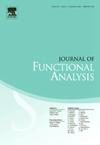Strongly convergent unitary representations of limit groups
IF 1.7
2区 数学
Q1 MATHEMATICS
引用次数: 0
Abstract
We prove that all finitely generated fully residually free groups (limit groups) have a sequence of finite dimensional unitary representations that ‘strongly converge’ to the regular representation of the group. The corresponding statement for finitely generated free groups was proved by Haagerup and Thorbjørnsen in 2005. In fact, we can take the unitary representations to arise from representations of the group by permutation matrices, as was proved for free groups by Bordenave and Collins.
As for Haagerup and Thorbjørnsen, the existence of such representations implies that for any non-abelian limit group, the Ext-invariant of the reduced -algebra is not a group (has non-invertible elements).
An important special case of our main theorem is in application to the fundamental groups of closed orientable surfaces of genus at least two. In this case, our results can be used as an input to the methods previously developed by the authors of the appendix. The output is a variation of our previous proof of Buser's 1984 conjecture that there exist a sequence of closed hyperbolic surfaces with genera tending to infinity and first eigenvalue of the Laplacian tending to . In this variation of the proof, the systoles of the surfaces are bounded away from zero and the surfaces can be taken to be arithmetic.
求助全文
约1分钟内获得全文
求助全文
来源期刊
CiteScore
3.20
自引率
5.90%
发文量
271
审稿时长
7.5 months
期刊介绍:
The Journal of Functional Analysis presents original research papers in all scientific disciplines in which modern functional analysis plays a basic role. Articles by scientists in a variety of interdisciplinary areas are published.
Research Areas Include:
• Significant applications of functional analysis, including those to other areas of mathematics
• New developments in functional analysis
• Contributions to important problems in and challenges to functional analysis

 求助内容:
求助内容: 应助结果提醒方式:
应助结果提醒方式:


